- Cart 0
- English
[IF 15.7] How Does Bcl11a Regulate Hematopoietic Stem Cell Aging? Absin ELISA Kits Advance Inflammatory Mechanism Research
October 09, 2025
Clicks:105
During aging, the functional decline of hematopoietic stem cells (HSCs) leads to a series of health issues such as anemia and immune deficiency. The underlying molecular mechanisms have long been a focal point in immunology and aging research. Recently, a research team from Tongji University and other institutions published a groundbreaking study in *Science Immunology* titled “Bcl11a maintains hematopoietic stem cell function but accelerates inflammation-driven exhaustion during aging”, revealing the dual role of the transcription factor Bcl11a in HSC aging. This discovery offers a novel therapeutic target for delaying hematopoietic system aging and improving related diseases. In this high-quality study, Absin’s IL-1β ELISA Kit (Cat#: abs520001) played a key role in elucidating the inflammatory mechanisms, providing reliable support for the research findings.

Background: Focusing on HSC Aging and Decoding the “Double-Edged Sword” of Bcl11a
Hematopoietic stem cells (HSCs) are essential for maintaining lifelong hematopoietic and immune system homeostasis. However, their function deteriorates with age, characterized by reduced self-renewal capacity, accumulated DNA damage, and lineage skewing. Previous studies have shown that the transcription factor Bcl11a is highly expressed in young HSCs and plays a critical role in maintaining their multipotency. It is also aberrantly overexpressed in various hematologic malignancies. However, the exact role of Bcl11a in HSC aging remains unclear—is it a “protector” or an “accelerator”?
The research team hypothesized that Bcl11a exerts a dual impact on HSC aging through both cell-autonomous (direct regulation of HSC function) and non-cell-autonomous (modulation of the bone marrow microenvironment) mechanisms. To test this hypothesis, a series of elegant experiments were designed. The inflammatory cytokine IL-1β, a key signaling molecule in the bone marrow niche, became a central link between Bcl11a function and HSC aging—this is where Absin’s abs520001 product played a pivotal role.
Research Strategy: From Cell-Autonomous Effects to Microenvironmental Regulation—Dissecting Bcl11a’s Mechanism of Action
1. Constructing an Inducible Chimeric Mouse Model to Track the Cell-Autonomous Role of Bcl11a
To overcome the limitations of traditional knockout/overexpression models, the team developed an inducible mosaic Bcl11a (iMOSBcl11a) mouse model. Using Cre recombinase, they generated mice with coexisting Bcl11a-overexpressing (T1-eGFP labeled) and control (T2-tdTomato labeled) cells within the same bone marrow microenvironment, allowing direct comparison of Bcl11a’s intrinsic effects on HSCs.
Results showed that Bcl11a-overexpressing HSCs (T1-eGFP+) exhibited significantly enhanced self-renewal capacity during aging, as evidenced by superior hematopoietic reconstitution efficiency post-transplantation, reduced DNA damage (fewer γH2AX foci), and maintained H4K16ac polarization (Figure 1). Multi-omics analyses (RNA-seq, ATAC-seq) further confirmed that Bcl11a promotes quiescence-associated gene expression and suppresses activation pathways, thereby protecting HSC function and delaying intrinsic aging.
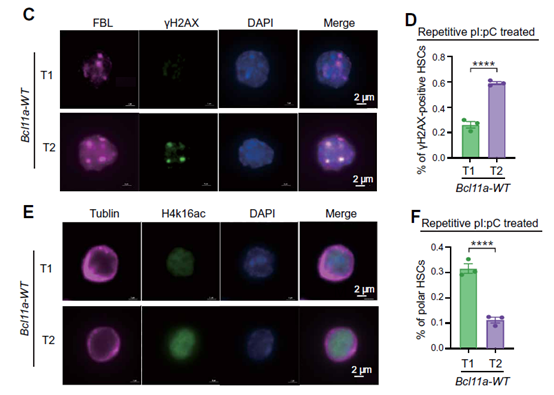
Figure 1: γH2AX foci indicating DNA damage are significantly reduced in Bcl11a-overexpressing HSCs; H4K16ac polarization is better maintained, scale bar = 2 μm
2. Identifying Fcer1g as a Key Target to Reveal Bcl11a’s “Anti-Activation” Mechanism
To identify the molecular target through which Bcl11a regulates HSC quiescence, the team performed CUT&Tag (chromatin binding analysis) combined with RNA-seq and ATAC-seq. They found that Bcl11a directly binds to the promoter region of the *Fcer1g* gene and represses its expression. *Fcer1g* encodes the common Fc receptor subunit, and its signaling promotes HSC differentiation at the expense of self-renewal (Figure 2).
Experimental validation showed that *Fcer1g* mRNA and protein levels were significantly reduced in Bcl11a-overexpressing HSCs, which became resistant to IgG immune complex (IC)-induced activation. Knocking out *Fcer1g* preserved HSC self-renewal even under inflammatory stress. These findings indicate that Bcl11a protects HSCs by inhibiting the *Fcer1g*-mediated activation axis.
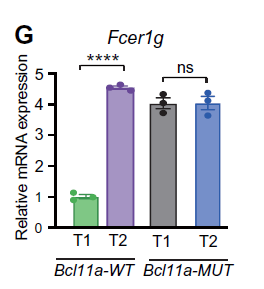 |
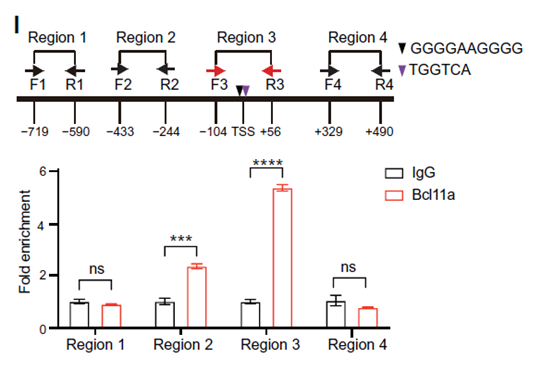 |
|||
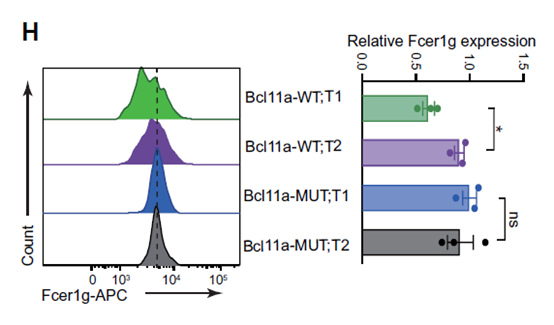 |
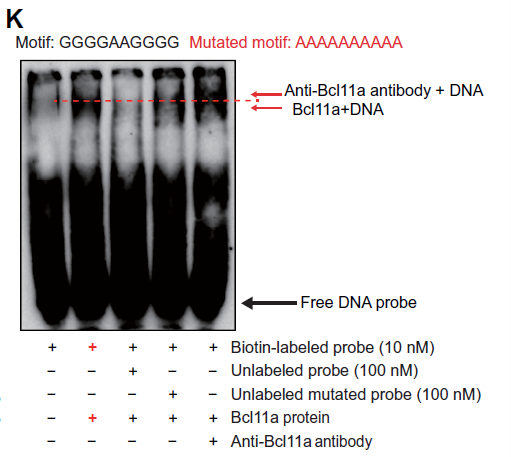 |
Figure 2: CUT&Tag confirms Bcl11a binding to the *Fcer1g* promoter; Bcl11a overexpression significantly reduces *Fcer1g* protein levels in HSCs; FMO serves as a negative control
3. Non-Cell-Autonomous Effects: Bcl11a Promotes IL-1β Secretion, Driving Bone Marrow Inflammation and HSC Exhaustion
Interestingly, the study revealed that Bcl11a is not merely a “protector”—its overexpression also disrupts the bone marrow microenvironment through non-cell-autonomous mechanisms:
- Step 1: Bcl11a promotes IL-1β secretion by myeloid cells. CUT&Tag and luciferase reporter assays showed that Bcl11a cooperates with the transcription factor PU.1 to bind the *IL-1β* promoter and enhance its expression.
- Step 2: Elevated IL-1β exacerbates HSC dysfunction by inducing *Fcer1g* expression and enhancing Fc receptor signaling, leading to HSC over-differentiation and loss of self-renewal (Figure 3).
- Key validation: Blocking IL-1β reverses HSC aging. Treatment with the IL-1 receptor antagonist Anakinra completely rescued the functional decline caused by Bcl11a overexpression.
In this critical step, Absin’s IL-1β ELISA Kit (abs520001) played a central role. The team accurately measured IL-1β levels in bone marrow fluid and myeloid cell culture supernatants, directly demonstrating that Bcl11a-overexpressing mice had significantly higher IL-1β concentrations and enhanced secretion capacity (Figure 3, right). This provided quantitative evidence supporting the conclusion that Bcl11a modulates the bone marrow microenvironment via IL-1β.
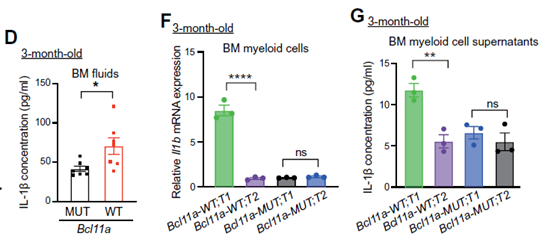
Figure 3: Bcl11a cooperates with PU.1 to activate the *IL-1β* promoter; Absin abs520001 shows significantly elevated IL-1β levels in bone marrow fluid of Bcl11a-overexpressing mice, n=7, *P<0.01
4. Summary: The “Dual Role” of Bcl11a and the Central Role of the IL-1β–Fcer1g Axis
Integrating all findings, the team proposed a “dual mechanism model” for Bcl11a in HSC aging (Figure 4):
- Cell-autonomous protection: Bcl11a directly represses *Fcer1g* expression, maintaining HSC quiescence and delaying intrinsic functional decline.
- Non-cell-autonomous damage: Bcl11a promotes IL-1β secretion by myeloid cells, activating the IL-1β–*Fcer1g* axis and accelerating HSC exhaustion.
This model perfectly explains the “double-edged sword” effect of Bcl11a in HSC aging and provides a clear direction for therapeutic intervention—e.g., modulating Bcl11a expression or blocking IL-1β signaling to preserve HSC function and improve the microenvironment.
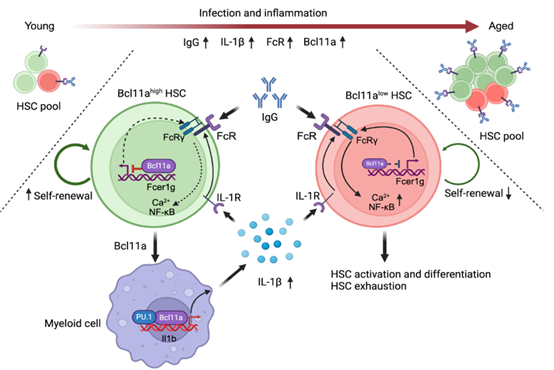
Figure 4: Red arrows indicate Bcl11a’s non-cell-autonomous damaging effects; green arrows indicate its cell-autonomous protective effects; Absin abs520001 was used to detect IL-1β levels and validate microenvironmental regulation
III. Absin abs520001: Precise Detection of IL-1β to Support Inflammatory Mechanism Research
In this study, Absin’s Mouse IL-1β ELISA Kit (Cat#: abs520001) was not merely a detection tool—it served as a critical link between Bcl11a regulation and microenvironmental inflammation. Why did the research team trust this kit? Its core advantages lie in the following three aspects:
- High Sensitivity and Specificity: The kit accurately detects IL-1β levels in mouse bone marrow fluid, cell culture supernatants, and other sample types, with a detection limit as low as the pg level, effectively distinguishing subtle differences between experimental groups.
- Easy Operation and High Reproducibility: Following the kit protocol allows for rapid batch processing of samples, with inter-assay CV values <10%, ensuring data reliability.
- Compatible with Multiple Sample Types: Whether using freshly collected bone marrow fluid or in vitro cultured myeloid cell supernatants, the kit delivers consistent and stable results, meeting the needs of various experimental scenarios.
As demonstrated in this study, abs520001 not only confirmed the promoting effect of Bcl11a overexpression on IL-1β secretion but also provided direct quantitative evidence that IL-1β is a key mediator of Bcl11a’s non-cell-autonomous effects—making it a powerful driver of the study’s breakthrough.
IV. Research Significance and Future Perspectives
This study not only elucidates the dual role of Bcl11a in HSC aging but also provides new therapeutic targets for related diseases. For example, in cases of hematopoietic dysfunction following chemotherapy or CAR-T therapy, modulating Bcl11a expression or blocking IL-1β signaling could promote HSC recovery. Moreover, this research offers a novel perspective on the link between inflammation and aging.
As a reliable partner in life science research, Absin remains committed to providing researchers with high-quality reagents and tools—from ELISA kits and antibodies to small molecules and compounds. We aim to support more breakthrough studies like this one and contribute to the advancement of life sciences. In the future, we look forward to seeing Absin products play a role in more immunology, aging, and oncology studies, providing solid support for scientific discovery and translation.
Product Used
|
Product Name |
Cat. No. |
Application |
|
Detection of IL-1β levels in serum, bone marrow fluid, and cell culture supernatants |
More ELISA Kits
| Cat. No. | Product Name |
| abs510001 | Human IL-2 ELISA Kit |
| abs510002 | Human IL-1 beta ELISA Kit |
| abs510003 | Human IL-6 ELISA Kit |
| abs520002 | Mouse IL-2 ELISA Kit |
| abs520003 | Mouse IL-4 ELISA Kit |
| abs530005 | Rat IL-2 ELISA Kit |
| abs530006 | Rat IL-4 ELISA Kit |
| abs530007 | Rat TNF-α ELISA Kit |
| abs540001 | Porcine IFN-gamma ELISA Kit |
| abs540002 | Porcine IL-1 beta ELISA Kit |
| abs540003 | Porcine IL-6 ELISA Kit |
For more product information or technical support, please visit the Absin official website at www.absin.net or contact our technical support team. We are dedicated to providing you with professional services!
Absin provides antibodies, proteins, ELISA kits, cell culture, detection kits, and other research reagents. If you have any product needs, please contact us.
|
Absin Bioscience Inc. Email: worldwide@absin.cn |
 Follow us on Facebook: Absin Bio Follow us on Facebook: Absin Bio |
